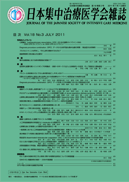Volume 18, Issue 3
Displaying 1-27 of 27 articles from this issue
- |<
- <
- 1
- >
- >|
HIGHLIGHTS IN THIS ISSUE
-
2011Volume 18Issue 3 Pages 325-327
Published: July 01, 2011
Released on J-STAGE: January 15, 2012
Download PDF (497K) -
2011Volume 18Issue 3 Pages 327-329
Published: July 01, 2011
Released on J-STAGE: January 15, 2012
Download PDF (483K) -
2011Volume 18Issue 3 Pages 330-333
Published: July 01, 2011
Released on J-STAGE: January 15, 2012
Download PDF (486K) -
2011Volume 18Issue 3 Pages 334-336
Published: July 01, 2011
Released on J-STAGE: January 15, 2012
Download PDF (424K)
REVIEW ARTICLE
-
2011Volume 18Issue 3 Pages 337-345
Published: July 01, 2011
Released on J-STAGE: January 15, 2012
Download PDF (344K)
COMMENTARY ARTICLE
-
2011Volume 18Issue 3 Pages 347-354
Published: July 01, 2011
Released on J-STAGE: January 15, 2012
Download PDF (460K)
ORIGINAL ARTICLES
-
2011Volume 18Issue 3 Pages 355-362
Published: July 01, 2011
Released on J-STAGE: January 15, 2012
Download PDF (444K) -
2011Volume 18Issue 3 Pages 363-368
Published: July 01, 2011
Released on J-STAGE: January 15, 2012
Download PDF (396K) -
2011Volume 18Issue 3 Pages 369-373
Published: July 01, 2011
Released on J-STAGE: January 15, 2012
Download PDF (288K)
CASE REPORTS
-
2011Volume 18Issue 3 Pages 375-380
Published: July 01, 2011
Released on J-STAGE: January 15, 2012
Download PDF (415K) -
2011Volume 18Issue 3 Pages 381-385
Published: July 01, 2011
Released on J-STAGE: January 15, 2012
Download PDF (428K) -
2011Volume 18Issue 3 Pages 387-392
Published: July 01, 2011
Released on J-STAGE: January 15, 2012
Download PDF (923K) -
2011Volume 18Issue 3 Pages 393-396
Published: July 01, 2011
Released on J-STAGE: January 15, 2012
Download PDF (309K) -
2011Volume 18Issue 3 Pages 397-400
Published: July 01, 2011
Released on J-STAGE: January 15, 2012
Download PDF (279K) -
2011Volume 18Issue 3 Pages 401-404
Published: July 01, 2011
Released on J-STAGE: January 15, 2012
Download PDF (348K) -
2011Volume 18Issue 3 Pages 405-409
Published: July 01, 2011
Released on J-STAGE: January 15, 2012
Download PDF (397K)
BRIEF REPORTS
-
2011Volume 18Issue 3 Pages 411-412
Published: July 01, 2011
Released on J-STAGE: January 15, 2012
Download PDF (357K) -
2011Volume 18Issue 3 Pages 413-414
Published: July 01, 2011
Released on J-STAGE: January 15, 2012
Download PDF (238K) -
2011Volume 18Issue 3 Pages 415-416
Published: July 01, 2011
Released on J-STAGE: January 15, 2012
Download PDF (228K) -
2011Volume 18Issue 3 Pages 417-418
Published: July 01, 2011
Released on J-STAGE: January 15, 2012
Download PDF (269K) -
2011Volume 18Issue 3 Pages 419-420
Published: July 01, 2011
Released on J-STAGE: January 15, 2012
Download PDF (253K) -
2011Volume 18Issue 3 Pages 421-422
Published: July 01, 2011
Released on J-STAGE: January 15, 2012
Download PDF (213K) -
2011Volume 18Issue 3 Pages 423-424
Published: July 01, 2011
Released on J-STAGE: January 15, 2012
Download PDF (232K) -
2011Volume 18Issue 3 Pages 425-426
Published: July 01, 2011
Released on J-STAGE: January 15, 2012
Download PDF (408K) -
2011Volume 18Issue 3 Pages 427-428
Published: July 01, 2011
Released on J-STAGE: January 15, 2012
Download PDF (335K)
INVESTIGATION REPORTS
-
2011Volume 18Issue 3 Pages 429-432
Published: July 01, 2011
Released on J-STAGE: January 15, 2012
Download PDF (383K) -
2011Volume 18Issue 3 Pages 433-440
Published: July 01, 2011
Released on J-STAGE: January 15, 2012
Download PDF (723K)
- |<
- <
- 1
- >
- >|
